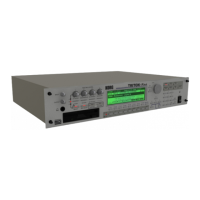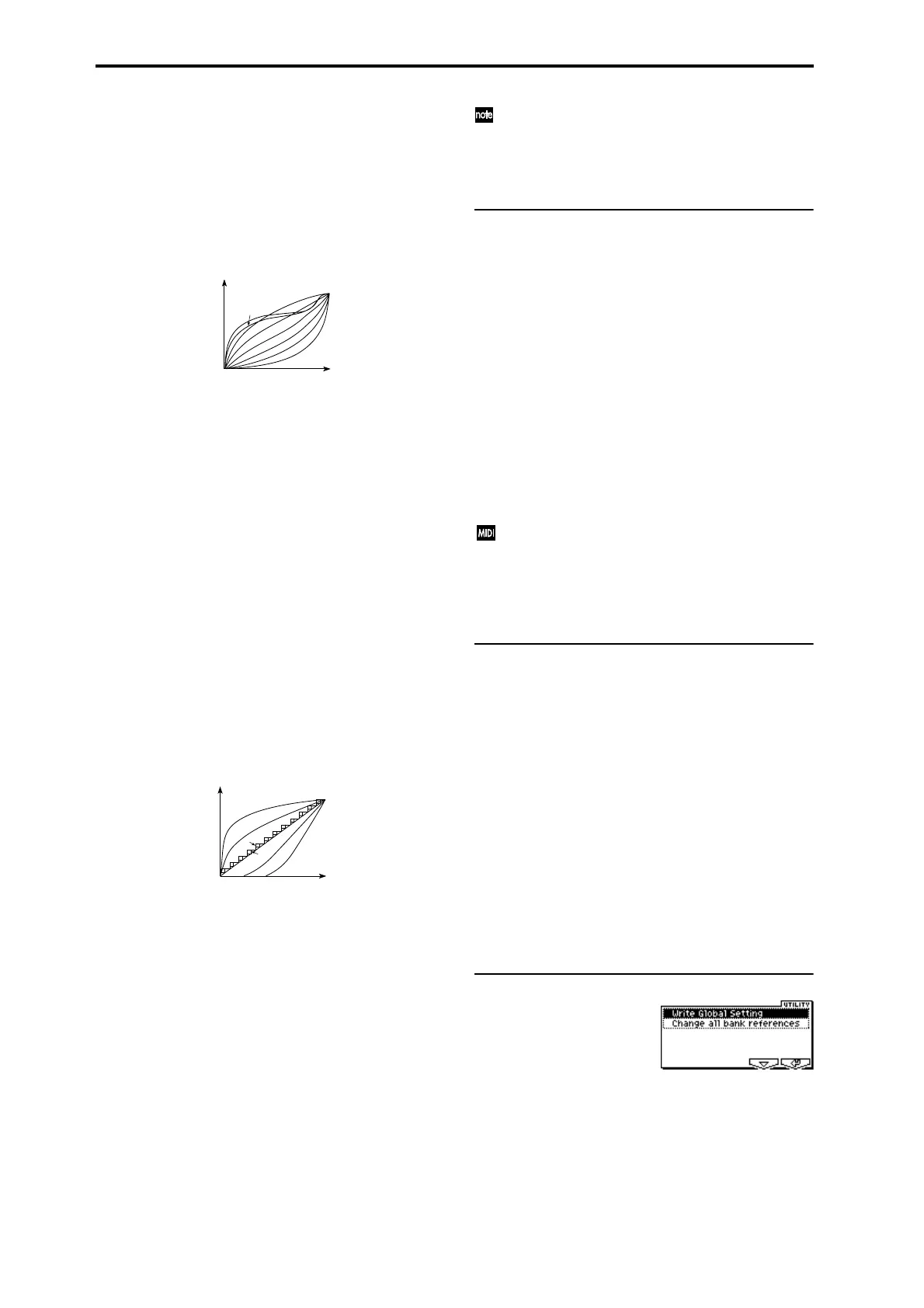108
Velocity Curve [1…8]
This specifies the way in which the volume and/or tone will
change in response to variations in keyboard playing
dynamics (velocity). The effect of velocity will change
according to the received velocity as shown in the diagram
below. If the notes played on an external keyboard or
sequencer and sounded by the TRITON-Rack are too bright
or too muted overall, you can select an appropriate velocity
curve here.
1: These curves produce an effect for strongly-played notes.
2, 3: |
4(Nomal): These are the standard curves.
5: |
6: An effect will be obtained even if you do not play very
strongly
7: A certain amount of effect will be obtained even for softly-
played notes
8: This curve produces the most regular effect. This setting is
suitable when you do not need velocity sensitivity, or when
you wish to make the notes more consistent. However with
this curve, control of softly-played notes will be more diffi-
cult, so use the curve that is most appropriate for your play-
ing strength and style, and the effect that you wish to
produce.
With the factory settings, this is set to 4.
AfterT Curve (AfterTouch Curve) [1…8]
This specifies the way in which the volume and/or tone will
change in response to variations in pressure (after touch).
Incoming aftertouch messages (pressure applied to the key-
board) will control the aftertouch effect as shown in the dia-
gram below.
1: These curves produce an effect for strongly-applied pres-
sure.
2: |
3(Nomal): These are the standard curves.
4: |
5: This curve produces change even when light pressure is
applied
6, 7: These curves produce change in 24 or 12 steps respec-
tively,. Curve number 7 allows change over twelve steps, so
when using after touch to modify the pitch, you can set the
range of modification to one octave, and use after touch to
vary the pitch in semitone steps.
8: This is a random curve. Use this when you wish to create
special effects, or to use after touch to apply unpredictable
modulation.
With the factory settings, this is set to 3.
Since the “Velocity Curve” and “AfterT Curve” settings
are applied immediately before the TRITON-Rack’s
internal tone generator, they will affect how incoming
MIDI data is played, but will not affect the MIDI data
that is transmitted.
1.1–1b: FX SW
IFX1–5 Off [Off, On]
On (Checked): All insert effects IFX1–5 will be off.
Off (Unchecked): The Setup tab page (7.2–1) “IFX1 On/
Off”–“IFX5 On/Off” settings of Program, Combination,
Multi, and Sampling modes will be valid.
MFX1 Off [Off, On]
On (Checked): MFX1 will be off.
Off (Unchecked): The Master Effect Setup tab page (7.3–1)
“MFX1 On/Off” settings of Program, Combination, and
Multi modes will be valid.
MFX2 Off [Off, On]
On (Checked): MFX2 will be off.
Off (Unchecked): The Master Effect Setup tab page (7.3–2)
“MFX2 On/Off” settings of Program, Combination, and
Multi modes will be valid.
When “IFX1 On/Off”–“IFX5 On/Off,” or “MFX1 On/
Off,” “MFX2 On/Off” settings are switched, control
change messages CC#92 (effect control 2), CC#94
(effect control 4), and CC#95 (effect control 5) will be
transmitted respectively. The transmitted data will be 0
for off, and 127 for on.
1.1–1c: Auto Arp. (Auto Arpeggiator)
Program (Auto Arp. Program) [Off, On]
On (Checked): When a different program is selected, the
arpeggiator settings stored in that program will automati-
cally take effect.
Off (Unchecked): The arpeggiator settings will not change
when the program is switched. Use this setting when you
wish to keep the same arpeggiator pattern running while
you select different program sounds.
Combi (Auto Arp. Combi) [Off, On]
On (Checked): When a different combination is selected, the
arpeggiator settings stored in that combination will auto-
matically take effect.
Off (Unchecked): The arpeggiator settings will not change
when the combination is switched. Use this setting when
you wish to keep the same arpeggiator pattern running
while you select different combination sounds.
■ 1.1–1d: UTILITY
For details on how to select the desired utility function, refer
to “PROG 1.1–1d: UTILITY.”
1
MAX
127
Velocity
effect
Velocity (MIDI In→TG)
1
8
6
5
4
3
2
7
1
0
MAX
127
After
Touch
effect
After Touch (MIDI In→TG)
3
4
5
7
2
6
8:RANDOM

